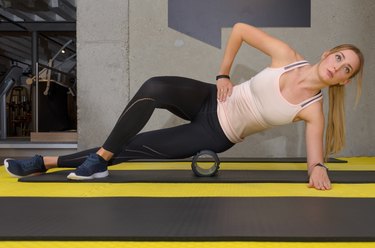
If you spend a lot of time on your feet, you might get knots in your legs. You might not want to touch these tight bands of muscle tissue — also known as trigger points — as they can cause pain. Foam rolling, stretching and massage can help you decrease this sensitivity.
Tip
If you have muscle knots in your legs, you might want to consider using the active release technique. The authors of a January 2014 paper in the International Journal of Physiotherapy and Research tested 40 healthy adults and showed that this manual therapy causes an immediate increase in range of motion.
Video of the Day
Video of the Day
Understand Knots in Legs
Ultrasound pictures of muscle knots from a July 2013 paper in Current Pain and Headache Reports show that trigger points have 50 percent more stiffness than surrounding areas. Gently running your hands over the affected area reveals tender knots of inflamed tissue.
The writers of a January 2014 article in Current Rheumatology Reports believe that these knots indicate a contracture — a small area of irritated muscle fibers. Your muscle has only partial damage. Thus, a knot in your thigh doesn't mean damage to the entire hamstring or quadriceps muscle.
Try Foam Rolling for Knots
People have increasingly made foam rollers part of their warm-up routine. These popular exercise tools can also help you remove knots. The authors of a January 2019 in Sports tested 20 younger men using foam rollers and bicycles.
The team found that foam rolling decreased thigh stiffness and jump performance. They also found that cycling increased thigh stiffness and jump performance. These findings suggest that cycling is a better for warming-up, and rolling is better for recovery.
Foam rollers can offer you other health benefits as well. They can, for example, increase your flexibility. The writers of a November 2015 report in the International Journal of Sports Physical Therapy used a meta-analysis technique featuring 260 subjects to show that foam rolling causes an increase in range of motion.
These researchers found this result irrespective of the timing of the rolling. That is, foam rolling increases flexibility when used either before or after exercise. Few studies have looked at the mechanisms underlying this effect. Removing muscle knots might play a role, according to an August 2013 paper by the National Academy of Sports Medicine.
Read more: DOs and DON'Ts of Foam Rolling
Use Partner Stretching for Knots
Stretching offers you the easiest way to remove knots in your legs. That's because you don't need any special tools to do it. The authors of a June 2013 report in the Journal of Physical Therapy Science tested the effectiveness of a special type of partner stretching called proprioceptive neuromuscular facilitation in 32 subjects with active trigger points.
This technique involves three steps: (1) passively stretching a muscle, (2) simultaneously contracting that same muscle and (3) then passively stretching it again with greater intensity.
Compared to baseline, the proprioceptive neuromuscular facilitation technique decreased feelings of sensitivity and pain in the participants. The authors believe that the treatment increased muscle control, decreased muscle tightness and improved blood flow.
Other known benefits of proprioceptive neuromuscular facilitation include increased flexibility, according to a July 2017 review in the European Journal of Physiology. You typically need a partner to do proprioceptive neuromuscular facilitation, but you can do a modified version alone.
Read more: Why Is Stretching Painful?
Dry Needling Intervention
The authors of a December 2016 report in the Journal of Chiropractic Medicine wanted to heal the contractures associated with muscle knots. These researchers tested 31 subjects and found that dry needling caused contracture healing.
For example, this treatment decreased trigger point pain within a few days. While the mechanism underlying this change remains unknown, the writers speculated that dry needling might stretch the damaged muscle fibers and thereby promote healing.
Despite this success, dry needling represents an extreme approach fraught with large risks. The writers of an April 2013 report in the International Journal of Sports Physical Therapy note that the needles can damage underlying organs, cause infection and break off. Fortunately, you can choose less invasive alternatives like foam rolling and massage.
- International Journal of Physiotherapy and Research: "Immediate Effect of Active Release Technique Versus Mulligan Bent Leg Raise in Subjects With Hamstring Tightness"
- Current Pain and Headache Reports: "Targeting Myofascial Taut Bands by Ultrasound"
- Current Rheumatology Reports: "Myofascial Trigger Points"
- Journal of Chiropractic Medicine: "Clinical Effectiveness of Dry Needling Immediately After Application on Myofascial Trigger Point in Upper Trapezius Muscle"
- International Journal of Sports Physical Therapy: "Use of Trigger Point Dry Needling and Intramuscular Electrical Stimulation for a Subject With Chronic Low Back Pain"
- Sports: "Foam Rolling of the Calf and Anterior Thigh"
- International Journal of Sports Physical Therapy: "Effects of Self‐Myofascial Release Using a Foam Roll or Roller Massager on Joint Range of Motion, Muscle Recovery and Performance"
- National Academy of Sports Medicine: "Foam Rolling — Self-Myofascial Release Technique"
- Journal of Physical Therapy Science: "Effect of Proprioceptive Neuromuscular Facilitation Therapy on Pain and Function"
- European Journal of Physiology: "Comparison Between Static Stretching and Proprioceptive Neuromuscular Facilitation on Hamstring Flexibility"